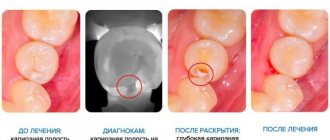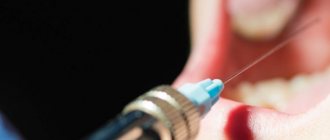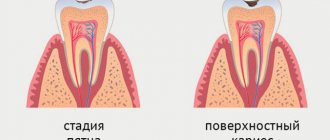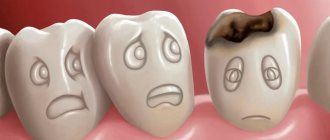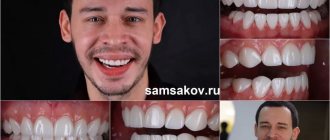Caries is a pathological process characterized by damage to the hard tissues of the tooth and further formation of a cavity in it. In recent years, caries of primary teeth has become a fairly common problem. By the age of 6-7 years, until permanent teeth begin to appear, more than 70% of children have lesions on their baby teeth, and most of them go to the dentist with complications or an advanced process. Most often, caries of primary teeth is detected at 2-3 years of age, but sometimes it can also occur in children who are not yet two years old. In different regions of the country, the prevalence of this form of caries by the age of four is 20-80%. How can such problems be avoided and what do parents need to know?
Causes of caries
Most often, caries of primary teeth can form under the influence of several factors simultaneously. Its most common causes are:
- Damage to tooth germs in the prenatal period. In the embryo, tooth buds begin to form in the first trimester of pregnancy. That is why any illnesses of the expectant mother that she suffered during this period, as well as the use of medications, can contribute to the fact that the fetus’s proper development of teeth is disrupted.
- Insufficient oral hygiene or its absolute absence. In this case, food particles remain on the teeth, and this is an excellent environment for the life and proliferation of bacteria.
- Incorrect eating habits - using pacifiers for a long time. Those children who are unable to switch from drinking from a bottle to a sippy cup or cup for a long time, and especially those who have learned to fall asleep every evening with a bottle or pacifier in their mouth, are at risk of developing bottle caries. With this pathology, through prolonged contact with the teeth of the liquid from the bottle (especially if it is sweet), the front teeth are affected by caries, and the process spreads along the circumference of the crown part of the tooth (along the perimeter of its visible part).
- Insufficient amounts of food in the daily diet, which requires intense chewing and leads to increased salivation, due to which the teeth are cleaned naturally. This factor is inherent in children under two years of age; it is one of the causes of early caries.
- Lack of calcium in food and water - the main building material of teeth and fluorides, which strengthen tooth enamel and protect against caries, preventing the possibility of its development.
- Rickets – with this pathology in children, tooth tissue is easily destroyed.
- Physiologically determined low resistance of children's dental tissue to agents that cause caries.
- Anomalies of dentition and bite.
- Hereditary predisposition.
- Chronic diseases, as well as frequent respiratory diseases, which reduce the overall resistance of the body.
- Excessive amounts of carbohydrates in a child’s food contribute to the development of caries in two ways simultaneously: they feed bacteria, and in the process of their decay, organic acids are formed that damage tooth enamel. For the formation of caries, it is not so much the total amount of carbohydrates consumed that matters, but the frequency of their intake.
Without a doubt, a child who is not yet three years old should not snack between meals, especially food containing a high amount of carbohydrates (sweets, chocolate, etc.). Instead, it is better to offer your baby fruits, marshmallows, marmalade, pastries, and dried goods. It is better to eat sweets after breakfast or dinner, and then brush your teeth after a while. Almost all children do not grow up without sweets, but their consumption should be limited and reasonable.
What does bottle caries look like and where does it develop?
Bottle caries always begins its development in the most vulnerable part of a baby tooth, in the cervical area, since it is in this area that bacterial plaque accumulates. The vulnerability of the cervical part of the teeth is due to the fact that mineralization of the enamel here occurs after the birth of a child in new and not always favorable conditions. The mineralization process can be negatively affected by the nature of nutrition (natural breastfeeding or artificial), social conditions, as well as various diseases: acute respiratory infections, intestinal infections, etc. The neck of the tooth becomes weakened and after eruption the enamel becomes vulnerable.
Why bottle caries
develops only on the upper central teeth of the child? To do this, you need to remember how the sucking process occurs in young children. During the process of sucking and swallowing, the tongue is located between the lower teeth and the mother's breast (or pacifier, respectively), so the main load (impact) falls on the upper front teeth. It is in this area that food debris and plaque accumulate.
The Forbidden fruit is sweet…
In order not to tempt your baby with “forbidden fruits,” simply do not buy them or consume them yourself. There is no doubt that your friends and relatives all bring sweets to the child solely with the best intentions. Try to talk to them and explain that instead of candy, you can bring your child, for example, a toy or an interesting book. Due to poor or complete lack of oral hygiene, the plaque that remains on the teeth after eating food turns into dental plaque containing bacteria that produce lactic acid, which damages the enamel and contributes to the development of caries. As soon as a child has his first teeth, he should immediately have age-appropriate toothpaste and a brush. Developing the habit of brushing your teeth at an early age twice a day (in the morning and also in the evening, after meals) will prevent many problems.
Anesthesia
| In our Clinic, pediatric dentistry means comfort and convenience for patients. And pain relief is almost unnoticeable for children. The anesthesia site is first treated with an anesthetic gel with fruit and berry flavor (jam), which children really like. This is done to ensure that the moment of anesthesia (injection) is painless. Anesthesia is carried out with a special syringe with a thin needle containing an anesthetic. The Clinic uses only the latest generation of anesthetics (we use Ultracain DS, Ultracain DS Forte, Ubistezin, Scandonest). A special syringe is used - a cerviject, which is not like a regular one and does not frighten the child. With its help, the required amount of anesthetic is reduced by 7-10 times and there is no numbness in the child’s lips or tongue. |
Signs of caries
Caries of primary teeth according to the depth of damage can be divided into the following types:
- Initial caries - in this case, white spots of different sizes and shapes appear on the enamel, but there is no pain. If left untreated, the process progresses and the spots darken, become black or brown. If you start timely treatment, you can stop the further development of caries.
- Superficial caries - a defect in dental tissues can be detected exclusively within the enamel. Pain occurs when exposed to sour, sweet, salty foods. A carious cavity can be dark or light. Treatment consists of filling the cavity.
- Medium caries - damage to tooth enamel and part of the dentin (intradental tissue) is detected. Painful sensations arise from hot, cold, salty, sweet. With this type of caries, the cavity is filled.
- Deep caries - the enamel is affected, as well as most of the dentin. When choosing a treatment method, the condition of the pulp is assessed and, depending on whether, filling or conservative treatment is carried out, in which therapeutic pads are used, and then delayed filling.
In children, multiple dental lesions are possible (20 baby teeth may be affected at once). In addition, during childhood, several carious cavities can occur in one tooth. Due to the physiological and anatomical structure of teeth, some children have a thinner layer of dentin and enamel, so hard tissues have a higher permeability, which is why the carious process quickly spreads along the surface of the tooth and deeper. This contributes to the spread of the process to deeper tissues and the development of periodontitis and pulpitis.
Initial stage of caries: clinical picture
The main cause of any caries is the activity of acid-forming bacteria (Streptococcus mutans and others). Poor hygiene and consumption of large amounts of carbohydrates are the main factors in the formation of dental plaque with an increased concentration of pathogenic microorganisms. The disease clearly demonstrates the mechanism of decay: with initial caries, minerals and trace elements are “washed out” in the enamel. Demineralization of enamel provokes the formation of small light spots: they signal the beginning of the carious process. Under microscopic magnification, these areas appear more porous and rough compared to healthy enamel. The protective properties and aesthetics of the enamel are noticeably reduced, but its structure is not disturbed. This is how initial and superficial caries differ: with the latter, the enamel layer is destroyed, which leads to a corresponding reaction of the tooth (in particular, to a reaction to temperature stimuli).
Stages of initial dental caries
- Chalk spot stage.
At this stage, the stain is white, much lighter compared to healthy areas of enamel. - Dark spot stage.
A more serious form of early caries affecting the deeper layer of enamel. Food coloring penetrates there, causing the stain to become brown or brown.
Stay vigilant
If you find plaque forming on your child’s teeth that you are unable to remove on your own, as well as brown or white spots, this indicates that the child urgently needs to be shown to a pediatric dentist. If the baby complains of discomfort that occurs when eating hot or cold food, this indicates the spread of caries into the deeper layers of the tooth. Parents should never ignore such complaints. It happens that a small child is not able to clearly communicate what is bothering him, so if he refuses food or a certain type of food, and also chews on one side, this may indicate toothache.
Complications of caries
The most typical complications of caries are pulpitis and periodontitis.
Pulpitis is a pathological process in which the inflammatory process affects the soft dental tissue (pulp). Symptoms of pulpitis can develop over several hours. This is preceded by minor pain, then acute pain occurs, more often at night or as a result of exposure to temperature stimuli. Such signs indicate that the carious cavity is most likely very deep and the dental pulp is affected. In this case, urgent dental intervention is necessary.
In the event that toothache has been observed repeatedly, the child has swelling of the gums or cheeks, and a fistula with purulent discharge is visible on the mucous membrane near the tooth, pain occurs as a result of biting on the tooth, then this indicates the spread of the pathological process beyond the tooth and inflammatory the process developed in the tissues that surround the tooth and a pathology such as periodontitis arose. When treating it, the doctor will choose the treatment tactics individually, but such a baby tooth is unlikely to be cured and will need to be removed.
Methods for treating caries
For caries in children at the initial stage of its development, enamel silvering can be used. In this case, a special solution containing silver ions is applied to the carious cavity (untreated). This is usually a temporary measure used to combat tooth decay. When using silver preparations, areas of the tooth affected by caries, that is, the carious stain itself, are persistently painted black, and this does not look very aesthetically pleasing. However, you don’t need to think that the entire tooth will turn black. Only the part affected by caries will darken, while the healthy part will remain unchanged white.
The most traditional methods of treating caries in primary teeth are removing the affected dental tissue with a drill using local anesthesia. The dentist decides on the need to use local or general anesthesia (anesthesia) individually in each case. Sometimes neither parents nor a doctor can persuade a child to open his mouth in order to treat or show his teeth. Most often, children under three years of age or those suffering from concomitant pathologies face this problem. Then it becomes necessary to treat teeth under general anesthesia. A child should not have any fear of the dentist. It is advisable that he become friends with him and understand that it is necessary to treat his teeth. After all, he will have to deal with this for the rest of his life. The child’s psychological mood largely depends on his parents and loved ones, who can convey to him their fear of visiting the dentist. Try to explain to your child the importance of a visit to the dentist and convince him that there is no need to be afraid of such a procedure.
Caries in children: why does it occur?
How to stop caries in a child? This question interests almost all parents, but in order for treatment to be more effective, you need to know the causes of this disease.
- Genetic predisposition.
Genetics is not a direct factor in the development of dental caries, but if parents have a predisposition to dental caries, then their children are likely to have similar dental problems. - Negative effects on the fetus during pregnancy.
Smoking, drinking alcohol and taking certain medications can adversely affect the development of the fetus and cause problems in the formation of tooth enamel (so-called congenital caries in children).
- Poor hygiene.
From the moment the first tooth appears, parents should begin to accustom their children to dental hygiene and help them with this. During the first year, children's teeth are especially sensitive and exposed to the influence of the external environment, so if special hygiene is not carried out, the child's first caries will not be long in coming.
- Wrong diet.
The most common cause of caries at the time of the appearance of a set of baby teeth. Chocolate, sweet drinks and other foods containing carbohydrates and accumulating in the interdental spaces contribute to the development of pathogenic bacteria, leading to the occurrence of disease. Bottle caries, caused by drinking sugary drinks through bottles with special nipples, is especially common.
- Calcium and fluoride deficiency.
Sometimes a child does not receive the required amount of calcium or fluoride, which are the main elements responsible for the integrity of tooth enamel. Diseases of the gastrointestinal tract. Gastritis, ulcers and other stomach diseases change the composition of saliva, as a result of which plaque forms on the teeth much more intensely. Caries in children and adolescents must be prevented, including by visiting a gastroenterologist.
- Infection with bacteria through cutlery and hygiene items.
Harmful microorganisms such as Streptococcus, which are the very “carious monsters,” can enter the child’s oral cavity through a spoon or toothbrush that belonged to a person who already has caries.
How to brush your teeth?
Each specialist has his own opinion about when to brush a child’s teeth using toothpaste. The composition of the toothpaste must correspond to the age of the baby - all information about this can be found on the packaging. Toothpastes for children under three years of age should not contain fluoride. Children at this age, not having the skills to rinse, swallow the paste. If a large amount of paste containing fluoride enters a child's body, serious health problems may arise, so in this case you should consult a doctor immediately. Children from about 4 years of age after brushing their teeth can partially spit out the remaining toothpaste. This is why toothpastes for this age contain fluorides. The maturation of tooth enamel is accelerated if hygiene products containing active fluoride are regularly used. This has been proven to help reduce the risk of tooth decay.
Children's toothbrushes are varied. For very small children, you can use special finger brushes, with which mother can easily remove plaque from her child’s teeth. By the age of 2.5-3 years, you gradually need to give the child a toothbrush in his hand and teach him to brush his teeth on his own.
Choose a toothbrush with soft bristles, the width of which corresponds to 2-3 teeth. It is recommended to change it every month, because frayed bristles can hurt your gums and are also a source of bacteria. The child should have an individual toothbrush; it should be stored separately, without a case, with the bristles facing up. Before brushing your teeth, as well as after the procedure, the brush should be rinsed well with running water. Oral care with additional hygiene products
- You can use dental floss or floss when all 20 baby teeth have erupted (most often at the age of 2-2.5 years). Dental floss should be used if the teeth fit tightly together. This must be done very carefully so as not to accidentally injure the gums.
- Dental rinses (elixirs) can be used as an additional hygiene product for children with a high risk of developing caries. Special children's elixirs contain fluoride in the amount that a child of a given age needs. You can use it twice a day after brushing your teeth or eating foods that contain a lot of sugar. Chewing gum should not be given to children until after 3 years of age. The sweeteners they contain (sorbitol, xylitol, etc.) have a beneficial effect on tooth enamel and prevent the occurrence of caries. Chewing gum also promotes increased salivation and self-cleaning of the oral cavity. They can be given to children regardless of the presence or absence of a filling in the mouth. Chewing duration is no more than 10-15 minutes.
Fluorescence of teeth (Conclusions)
Light is a simple and safe method for making a clear diagnosis. Fluorescence of teeth helps to quickly establish contact between the doctor and the patient. Using laser technologies, we can detect early and hidden caries, monitor its development, and control treatment.
The translation was made specifically for the OHI-S.COM website. Please, when copying material, do not forget to provide a link to the current page.
Literature
- Abdelaziz M, Krejci I. DIAGNOcam - a Near Infrared Digital Imaging Transillumination (NIDIT) technology. Int J Esthet Dent. 2015 Spring;10(1):158-65.
- Yu JL, Tang RT, Feng L, Dong YM. Digital imaging fiber optic transillumination (DIFOTI) method for determining the depth of cavity. Beijing Da Xue Xue Bao. 2022 Feb 18;49(1):81-85
- Young DA, Featherstone JD. Digital imaging fiber-optic trans-illumination, F-speed radiographic film and depth of approximal lesions. J Am Dent Assoc. 2005 Dec;136(12):1682-7.
- Astvaldsdóttir A, Ahlund K, Holbrook WP, de Verdier B, Tranæus S. Approximal Caries Detection by DIFOTI: In Vitro Comparison of Diagnostic Accuracy/Efficacy with Film and Digital Radiography. Int J Dent. 2012;2012:326401. doi: 10.1155/2012/326401. Epub 2012 Nov 4.
- Yang J, Dutra V. Utility of radiology, laser fluorescence, and transillumination. Dent Clin North Am. 2005 Oct;49(4):739-52, vi. Review.
- Söchtig F, Hickel R, Kühnisch J. Caries detection and diagnostics with near-infrared light transillumination: clinical experiences. Quintessence Int. 2014 Jun;45(6):531-8
https://styleitaliano.org/
How to brush your teeth correctly?
It happens that trying to brush your teeth can sometimes cause a negative reaction. But you don't need to get upset about it. Better be patient and play. Remember that a child under three years of age, and older children too, learn about the world through play. Therefore, do not insist on brushing your teeth; it is unlikely that the baby will understand that this is important. Just play. For such games, a battery-powered brush and a toy on the handle are perfect. The movements performed by the brush for different groups of teeth should differ from each other. Cleaning the front teeth should be done from the gums with unidirectional vertical movements. Move the brush behind the cheeks in a circular manner, while the teeth should be closed. Cleaning the chewing surface of the teeth is carried out with horizontal movements from the inside (from the palate and tongue), back and forth, sweeping upward like a “broom”. But not only the movements that are performed are important, but also how much time is devoted to it. There are two ways to check whether your teeth are being brushed adequately:
- – in terms of time (you need to spend about 7-10 minutes brushing all your teeth), for this you can use an hourglass or any other clock
- – by the number of movements (for each area occupied by the bristles of the brush, 5-6 movements are needed).
Proper nutrition
One of the preventive measures for dental diseases is a balanced diet - one in which the daily diet contains proteins, carbohydrates, fats, minerals and vitamins that are necessary for the formation and proper growth of dental tissues. In infants, this is breastfeeding. Older children need to include in their diet all the necessary types of complementary foods that are recommended for this age. Additional sources of fluoride can also be water and fluoridated salt; their use does not require special indications. The main sources of calcium are fermented milk products (cottage cheese, milk, cheese, etc.), buckwheat, gooseberries, potatoes, peas, oats, mineral water (some of its types).
First visit to the dentist
A child’s first visit to the dentist is most often necessary for the following reasons: for a preventive examination upon admission to a preschool or if complaints arise. Don't wait until after the age of four to visit the dentist for the first time. Subsequently, the child needs such visits twice a year. If the baby has already begun the carious process, then during this time it will not be able to spread deeply, caries complications such as periodontitis and pulpitis will not arise, and the tooth can be saved. The sooner the doctor can detect caries, the more successful and painless the treatment will be. Sometimes, in the initial stages of superficial caries, treatment can be carried out without instrumental intervention using mineralizing agents. In this case, medicinal solutions of calcium and phosphorus are applied to damaged areas of enamel. The dentist’s task is not only to provide dental treatment, but also preventive measures that will help keep teeth and gums healthy:
- professional oral hygiene (removal of dental plaque);
- treatment of teeth with calcium and fluoride preparations
- prescribing general treatment if necessary (internal intake of vitamin and mineral complexes);
- teaching your child how to properly brush their teeth;
- correction of the composition and diet, identification of bad habits together with parents;
- sealing fissures (grooves that are located on the chewing surface of the tooth) is a prevention method that is aimed at preventing caries from affecting permanent teeth.
